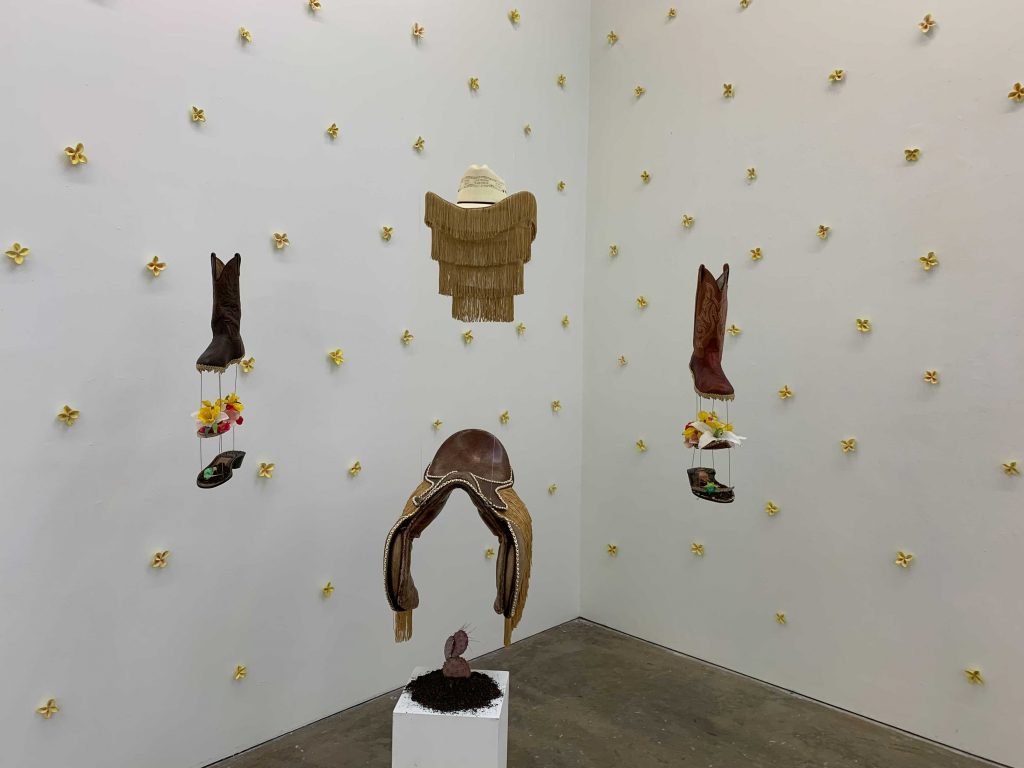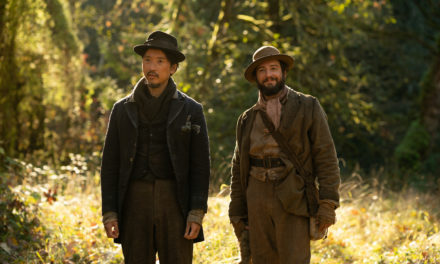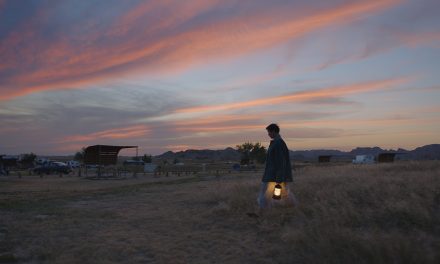A thick layering of plaster and paper mache coats a sprawling amebic form titled “Island with Two Lava Pits and Water Table” in the promotional material for the Atlanta Contemporary 2021 Biennial show, “Of Care and Destruction,” on display through Aug. 1. Landscape greens and soft pinks are applied in thick textured smudges. They carry the latent sense of touch, care and placement by local artist Tori Tinsley, whose sculpted topography of child-like imagination can be carefully analyzed like a map but is more readily entered into as a fantasy world.
This year’s Atlanta Biennial, curated by American University’s Department of Art Professional Lecturer Jordan Amirkhani, features the lively work of 36 Atlanta-based artists. A wall of text at the entrance explains the show is dedicated to Stacey Abrams, Helen Butler, Felicia Davis and Nse Ufot — Black women in Georgia whose activism and faith in democratic processes are awkwardly juxtaposed with the exhibition in a trite gesture common to much of the curator’s commentary. A cryptic quote attributed to Toni Morrison reads, “… perhaps art is just all our care in extensive form?” Unlike Amirkhani’s commentary across the museum labels, the works themselves are anything but stale. The works on display are original, provocative and utterly absorbing, making this thematically incoherent exhibition worth visiting.
Indeed, the objects featured in this year’s Atlanta Contemporary show lack subtlety, which is perhaps why the curator’s desperate attempts to thematically link them under groupings like “care and destruction” fall flat. The works advocate only for themselves and resist the imposition of a narrative. Consideration of material properties, artistic labor and intersectionality are not new to contemporary art. Despite the curator’s best efforts at branding, a slogan like “Of Care and Destruction” does a disservice to the works in an unsuccessful attempt to make them comfortably digestible and thematically cohesive when these works would be better understood on their own.
A remixed Angolan folk song spilleds into the gallery space as part of an installation “There are other hues of blue” by Le’Andra LeSeur. LeSeur’s moody beats work well in the gallery space, adding vibrancy onto the dull concrete floors and white walls. The installation’s songs feature beats better known as samples or remix lesser known tunes, sonically paralleling the accompanying glitched video of the sky from the Facebook live video of Sean Reed’s killing by police.
The music overwhelms other sonic installations, however, such as Adam Forrester’s video “Dirty Filthy Coat” (part of a different curation within the Biennial) whose brooding aura of mystery is ruptured by remixed world beats and Tarika Blue’s “Dreamflower.” Showcased within the intimately tapered “Sliver Space,” Forrester’s work also consists of assorted prints from Emory’s Stuart A. Rose Manuscript, Archives and Rare Book Library in a broader multimedia installation about the repressed dark history of his hometown of Phenix City, Alabama.

‘We Have Always Been’ by José Villalobos (The Emory Wheel/Robert Fuhriman)
Despite the aural dissonance, many of the works are thematically linked, especially along racial and gendered lines. Myra Greene’s “Piecework #49” is an angular explosion of gossamer textile dyed in complementary warm browns, yellows and purples, drawing attention to exploitative colonization and appropriation of Indonesian and West African textile art and the broader legacy of cotton in America. Meanwhile, Yanique Norman’s towering “Chytrids” overlays massive protruding headdresses on the photographed head of an unnamed 19th-century white woman as part of her aesthetic praxis of “Black fungibility.” The sculpture materially resists the flattening of the Black experience in a white-dominated society.
Jose Villalobos’ “We Have Always Been” likewise calls into question hierarchies of race and gender with his construction of camply masculine cowboy gear suspended in front of a dizzying burst of yellow flowers. The museum label highlights the desire of the artist to reconcile the artist’s pride in his Norteño heritage with the oppression he faced as a queer man in a hypermasculine culture. The work seems almost too obvious, corny even; the fake hummingbirds shown crushed between deconstructed layers of cowboy boots are particularly on the nose. This lack of subtlety is, of course, expected in a piece designed to celebrate campness, but the constructed space fails to provoke deeper contemplation.
Ultimately, the moments of continuity that persist between the distinct works at the Atlanta Contemporary Biennial show are actively suppressed by the uncompelling and shallow narrative of “Care and Destruction.” The works are far too radical and thought-provoking to be subject to meaningless categorization, and the intersectional analysis within the museum labels add little beyond a superficial level. The works themselves, however, demand the viewer face the struggle against oppression head-on.
Robert Fuhriman (22C) is from Berkeley, California, and is majoring in history and art history. His interests include architecture, visual arts and drinking Yerba Mate. Fuhriman is also interested in making abstract artistic ideas accessible to more people. Contact Fuhriman at robert.fuhriman@emory.edu.






